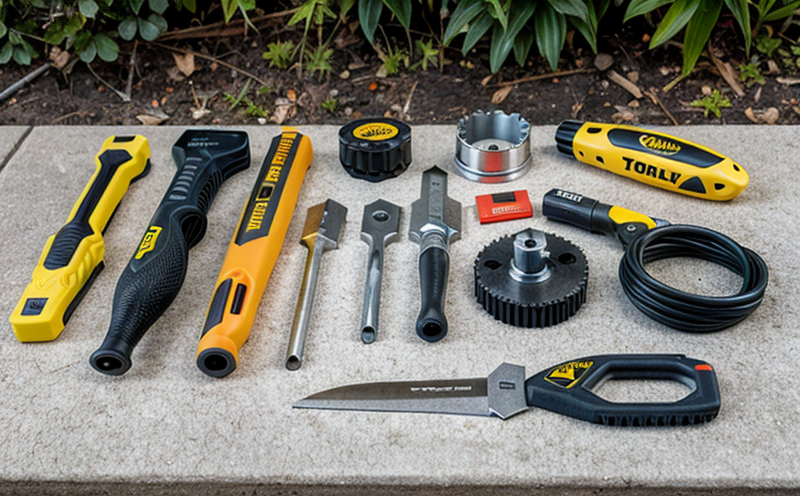Shock Resistance Testing of DIY Equipment
In today’s fast-paced world, DIY tools and hardware products have become indispensable. They are used in various sectors from home improvement to professional construction. However, these tools often undergo harsh conditions during use, which can lead to potential risks if not designed with safety in mind.
Shock resistance testing is a critical aspect of ensuring the durability and reliability of DIY equipment. This process simulates real-world shock scenarios that a product might encounter under normal usage conditions. The objective is to assess how well the tool withstands sudden impacts, vibrations, or drops without compromising its functionality or safety features.
The testing procedure typically involves placing the specimen on a vibration table or dropping it from a specified height onto a hard surface. Environmental factors such as temperature and humidity are also considered during testing to ensure that the results accurately reflect real-world conditions. Compliance with international standards like ISO 2631-1:2019, ASTM F4857, and EN 60941 is crucial for ensuring consistent quality across different regions.
For DIY tools, shock resistance testing plays a pivotal role in enhancing consumer safety by identifying weak points early in the product development cycle. This allows manufacturers to make necessary improvements before the products reach the market. By incorporating robust design elements and materials that can endure shocks without failure, companies not only meet regulatory requirements but also build trust with their customers.
The importance of this testing cannot be overstated. Not only does it protect users from potential injuries caused by faulty tools, but it also contributes to reducing waste generation through longer product lifecycles. When consumers know that they are investing in reliable equipment, there is less likelihood of premature disposal leading to environmental harm.
To achieve accurate and repeatable results, specialized testing facilities equipped with state-of-the-art machinery are necessary. Our laboratory adheres strictly to industry best practices ensuring precise measurements and consistent outcomes regardless of the batch being tested. With our experienced team of engineers and technicians working closely alongside you throughout each project phase, we provide comprehensive support tailored specifically for your needs.
Understanding these challenges allows us to develop solutions that address them effectively. In summary, shock resistance testing is essential not just because it meets regulatory requirements but more importantly because it ensures the safety and longevity of DIY tools used by millions worldwide every day.
Why It Matters
The significance of shock resistance testing cannot be understated when it comes to DIY tools and hardware products. These items are frequently subjected to rough usage conditions such as being dropped, mishandled, or exposed to extreme temperatures.
- Enhanced Safety: Ensures that users do not face any risks due to compromised equipment.
- Increased Durability: Extends the useful life of tools by identifying and rectifying weaknesses early on.
- Better Reputation: Builds trust among customers who appreciate well-tested products.
Moreover, complying with relevant standards adds value to your brand image. It demonstrates commitment towards producing safe and reliable goods which ultimately translates into customer satisfaction and loyalty.
Quality and Reliability Assurance
At our laboratory, we take pride in delivering accurate and reliable results through meticulous testing procedures. Our team of experts has extensive experience in analyzing various aspects of DIY tools including their mechanical properties, material composition, and electrical characteristics.
The process begins with careful preparation of the specimens according to predefined specifications ensuring consistency throughout all stages. Once prepared, each item undergoes rigorous evaluation using sophisticated instruments calibrated against industry benchmarks.
After completion of testing, comprehensive reports are generated detailing every aspect of performance including pass/fail status alongside detailed explanations of any discrepancies observed during analysis. These insights play a crucial role in guiding further developments aimed at enhancing overall quality and reliability standards.
Environmental and Sustainability Contributions
Shock resistance testing contributes significantly to environmental sustainability by promoting longer product lifecycles which reduce waste generation. When tools are designed robustly enough to endure harsh conditions without failure, they last longer before needing replacement leading to decreased consumption of resources.
- Reduced Waste: Longer-lasting products mean fewer replacements and disposals contributing positively towards environmental conservation efforts.
- Saved Resources: By extending the useful life span, less raw material is required resulting in lower energy consumption during manufacturing processes.
In conclusion, implementing robust shock resistance testing not only enhances product safety but also supports global sustainability goals by fostering efficient resource utilization and minimizing environmental footprints.





